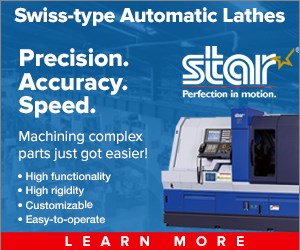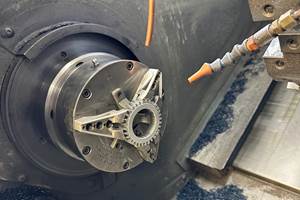Predicting the ROI of Robotic Automation
Various methodologies paired with online tools can help small to mid-sized manufacturers determine how to predict and calculate the potential economic benefits of robotic equipment for their specific needs.

This CubeBox modular cell is designed to be easily integrated various production lines and is compatible with CNC lathes, machining centers and grinding machines. Source (all images): Tezmaksan Robot Technologies
In today’s rapidly evolving industrial landscape, the integration of CNC robotic automation has shifted from being “nice to have” to a strategic necessity for manufacturers. Deloitte’s 2024 Manufacturing Industry Outlook report underscores this trend, with 86% of surveyed manufacturing executives acknowledging that smart factory solutions will be the primary drivers of competitiveness over the next five years.
While larger companies are leveraging automation, small and medium-sized manufacturers (SMMs) have been more hesitant. Less than half said they were willing to invest, according to a survey by the Smart Manufacturing Institute (CESMII) and the Society of Manufacturing Engineers (SME). A major concern is the perceived upfront investment in automation. As written in Harvard Business Review, “The robotics industry has traditionally been dominated by large, complex machines that require significant up-front investment and in-house expertise to keep them running.”
Fortunately, this is changing as industrial robots and automation systems become smaller, more modular and affordable. Another change is the growing popularity of return on investment (ROI) calculators to help more accurately predict the benefits of CNC automation.
Predicting Returns
Calculating the ROI for CNC robotic automation involves a systematic approach, starting with the identification of goals and objectives for implementing the automation in the first place. These objectives might include increased production efficiency, reduced labor costs, improved quality or enhanced production capacity.
Next, manufacturers should apply a comprehensive cost analysis, encompassing the initial investment and ongoing operational costs. The former includes purchase costs, installation, training and any necessary infrastructure changes on the factory floor. The latter considers maintenance, energy consumption and additional expenses related to running the robotic equipment.
Estimating labor cost savings is a pivotal step, as a crucial benefit of automation is the reduced need for manual intervention in the production process. Aside from reduced labor hours, there can be fewer production errors caused by human mistakes, too.

RoboCAM from Tezmaksan is a program used to control and monitor robotic operations while reducing the time spent instructing the robot. The platform is designed to eliminate the complexities of robotics programming, making it accessible to operators of all skill levels.
Through such calculations, automation equipment can be used to its optimal capability. One example is Tezmakasan Robot Technologies’ CubeBox system. The CubeBox is compatible with numerous CNC machines including lathes, machining centers and grinding machines. It also integrates with the existing robot operations, eliminating the need for extensive modifications or customization. Such compatibility simplifies the implementation process and minimizes downtime during the installation phase.
Offering the potential for 24 hours of operator-free operation, the core advantage of the CubeBox system also lies in its ability to work non-stop. Ensuring uninterrupted production even during night shifts, this continuous operation can lead to 50% increase in night shift efficiency compared to traditional setups that rely heavily on manual labor for CNC machine tending.
But beyond labor cost savings, manufacturers must also consider the impact on production capacity, quality improvements, downtime reduction, time-to-market enhancements and potential revenue increases.
Three Approaches to Robotic ROI
An effective ROI calculation involves subtracting operational costs from the net benefits (savings from labor, reduced downtime, increased capacity, quality improvements and so on), multiplying this by 100 and then dividing by the total cost which includes initial investment plus ongoing operational costs. Here are three ROI calculation measures to consider:
- Payback period. This is the time taken for the investment to be recovered from net cash inflows. It is a straightforward way to evaluate how fast a company can recoup its investment, calculated by dividing the amount of the initial investment by the annual net cash flow. A shorter payback period is generally preferred as it indicates a quicker ROI. Payback period is useful for assessing risk associated with the investment, especially in industries with rapid technological changes.
- Net present value (NPV). This accounts for the time value of money by discounting future cash flows to their present value. To calculate NPV, determine the cash flows for each period of the investment or project, discount them to present value and subtract the initial investment from the sum of the project’s discounted cash flows. A positive NPV means the investment is expected to generate value, giving a more accurate representation of the investment’s profitability.
- Internal rate of return (IRR). This compares the investment’s inherent rate of return to the required rate of return. If the IRR for proposal A exceeds the company’s cost of capital, which represents the required return on investment, the project is generally deemed acceptable. The formula for calculating IRR is: (End amount / starting amount)(1/n) – 1. (The variable “n” is years for investment return.)
Key Variables
Online ROI calculators are becoming more popular throughout industry. This includes Tezmaksan’s online ROI calculation tool. A range of important variables can be entered into the tool including investment cost, total expenses, the number of CNC operators, expected working days per year/hours per day, labor expenses, the price of the workpiece, insurance premiums and more. Based on these variables, users can calculate a definite ROI figure for the year.

Tezmaksan’s CubeBox Pallet Pool can manage up to 24 pallets and 16 tools using a single unit. Pallets are arranged in a compact circle in front of the machine and a six-axis robot handles the loading and unloading process.
To make the analysis more robust, manufacturers should perform sensitivity analysis to understand how changes in key variables such as production volume and labor costs impact the ROI. Additionally, it’s crucial to consider potential intangible benefits including improved employee morale, increased competitiveness and enhanced market reputation.
Calculating the ROI for robotic automation requires a meticulous analysis of tangible and intangible factors. Regularly reviewing and adjusting calculations ensures accuracy and relevance to the evolving business environment. By embracing automation strategically, manufacturers can not only improve their bottom line, but also position themselves competitively in the ever-changing market landscape.
Related Content
Replace Repetitive Measurement With DIY Robotic Automation
After minimal training, a shop can learn how to use this robotic inspection system configured for a shopfloor application to supersede repetitive, time-consuming, high-mix gaging processes. It can then be redeployed for another application somewhere else in the facility.
Read MoreAutomation Idea for Halloween?
Maybe not. But, the candy-throwing robots at MetalQuest’s Nebraska facility do enable the contract machine shop to stand out at career fairs and similar events.
Read MoreChuck Jaws Achieve 77% Weight Reduction Through 3D Printing
Alpha Precision Group (APG) has developed an innovative workholding design for faster spindle speeds through sinter-based additive manufacturing.
Read More4 Bright Ideas for Effective Lights-Out Machining
Adopting lights-out machining involves considerations when a machine shop decides to move forward with the process. Here are some tips to a successful implementation.
Read MoreRead Next
Do You Have Single Points of Failure?
Plans need to be in place before a catastrophic event occurs.
Read More5 Aspects of PMTS I Appreciate
The three-day edition of the 2025 Precision Machining Technology Show kicks off at the start of April. I’ll be there, and here are some reasons why.
Read MoreA Tooling Workshop Worth a Visit
Marubeni Citizen-Cincom’s tooling and accessory workshop offers a chance to learn more about ancillary devices that can boost machining efficiency and capability.
Read More











.jpg;maxWidth=300;quality=90)









